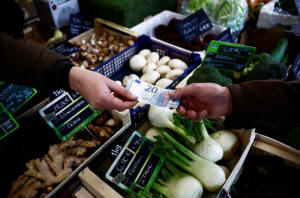Euro zone inflation unexpectedly eases, boosting rate cut case
 Send a link to a friend
Send a link to a friend
 [April 03, 2024] By
Balazs Koranyi [April 03, 2024] By
Balazs Koranyi
FRANKFURT (Reuters) - Euro zone inflation fell unexpectedly last month,
solidifying the case for the European Central Bank to start lowering
borrowing costs from record highs.
Consumer price growth in the 20 nations sharing the euro currency slowed
to 2.4% in March from 2.6% a month earlier, defying expectations for a
steady rate as food, energy and industrial goods prices all pulled the
headline figure lower.
Underlying inflation, closely watched by the ECB to gauge the durability
of price pressures, meanwhile fell to 2.9% from 3.1%, coming below
expectations for 3.0%, data from Eurostat, the EU's statistic's agency
showed on Wednesday.
The only potential concern for the ECB will be that services inflation
has been holding steady at 4.0% for months now, suggesting that
relatively quick wage growth is keeping prices in the sector under
constant pressure.

Inflation has been on a steady downward path for more than a year but
has fallen more quickly since last autumn than many had predicted,
shifting the debate to just how soon and how fast the ECB will unwind
record rate hikes.
Meeting next week, the central bank is expected to acknowledge the
improved outlook but policymakers are unlikely to cut rates straight
away, having repeatedly pointed to June as the next crucial meeting for
policy setting.
This is why investors see almost no chance of a cut on April 11 but have
fully priced in a move for June, followed by another two or three steps
later this year.
The ECB has been cautious in starting to ease policy because it only
expects inflation back at its 2% target next year, even as some private
forecasters take a more benign view, projecting the headline rate at
around 2% by this autumn.
The ECB has said it needs to see essential wage data from the early part
of the year before it is comfortable easing policy. Some policymakers
also fear that moving too far before the U.S. Federal Reserve begins
reducing rates could be counterproductive, since a cut would weaken the
euro and boost imported inflation.
[to top of second column] |

A shopper pays with a twenty euro banknote at a local market in
Nantes, France, February 1, 2024. REUTERS/Stephane Mahe/files

Wages have been growing relatively quickly in recent quarters but
the pace of growth is slowing and workers are still only slowly
recouping real purchasing power lost to several years of rapid
inflation.
Still, unemployment is holding at a record low 6.5%, separate
Eurostat data showed on Wednesday, suggesting that the labour market
remains exceptionally tight.
Although oil prices have been steadily increasing since the start of
the year, crucial natural gas prices remain low after an unusually
mild winter, pointing to mild but still manageable risks from energy
costs in the months ahead.
Dovish policymakers, meanwhile, argue that economic growth is now
exceptionally weak as the euro zone has been skirting a recession
for six quarters now.
This weakens corporate pricing power and thus eases price pressures,
so the ECB can afford to ease up on the brakes, especially since
lower commodity prices are also helping disinflation.
While the ECB is far from settled on how far rates could fall, most
appear to agree that the deposit rate, now at 4%, will restrict
growth at least until it hits 3%, so the initial cuts are more about
easing restriction than providing stimulus.
(Reporting by Balazs Koranyi; Editing by Toby Chopra)
[© 2024 Thomson Reuters. All rights
reserved.]
This material may not be published,
broadcast, rewritten or redistributed.
Thompson Reuters is solely responsible for this content.
 |